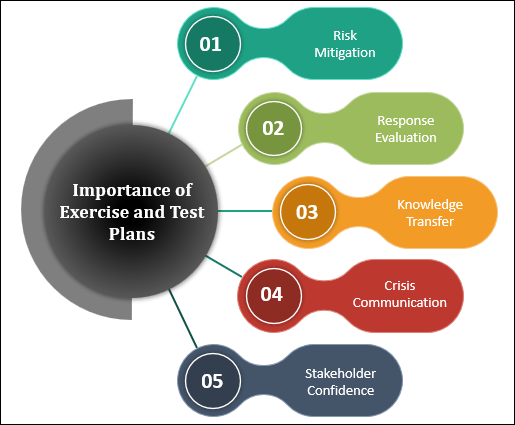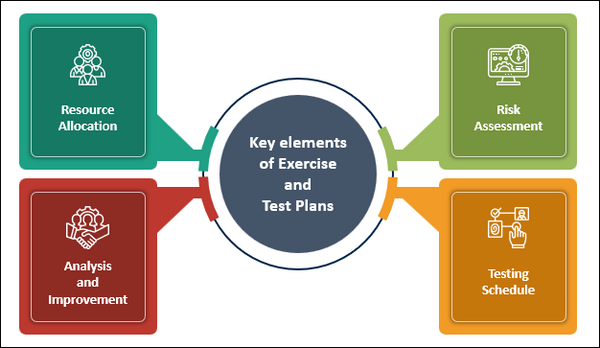ISO 22301 : Exercise and Test Plans in BCMS
ISO 22301, Exercise and Test Plans are indispensable tools that aid in evaluating an organization's ability to recover from crises effectively.These plans encompass a series of exercises and tests that simulate real-life emergency situations, allowing businesses to identify weaknesses in their BCMS and make necessary improvements. This introductory overview delves into the significance of Exercise and Test Plans in ISO 22301, shedding light on their critical role in enhancing an organization's resilience and ensuring business continuity."

Importance of ISO 22301 : Exercise and Test Plans in BCMS
- Risk Mitigation: Exercise and Test Plans help organizations identify vulnerabilities in their BCMS. By simulating real crises, businesses can pinpoint weaknesses and proactively address potential risks, reducing the likelihood of severe disruptions.
- Response Evaluation: These plans allow organizations to evaluate their response procedures. By practicing responses to various scenarios, they can refine their strategies, ensuring a more effective and coordinated response during actual incidents.
- Enhanced Resilience: ISO 22301 emphasizes the importance of resilience. Exercise and Test Plans contribute to enhancing an organization's resilience by promoting adaptability, resource optimization, and continuity in the face of adversity.
- Regulatory Compliance: Many industries have stringent regulatory requirements for business continuity. ISO 22301 compliance often requires regular testing and validation of BCMS. Exercise and Test Plans help organizations meet these compliance requirements.
- Stakeholder Confidence: Demonstrating a commitment to business continuity and preparedness through regular exercises and tests can instill confidence in stakeholders, including customers, partners, and investors.
- Crisis Communication: Effective communication is crucial during a crisis. These plans ensure that communication strategies are well-tested, helping maintain transparency and clarity when addressing various stakeholders.
- Resource Optimization: Running exercises and tests can reveal resource inefficiencies and redundancies. This insight allows organizations to optimize resource allocation, saving costs and improving overall efficiency.
- Continuous Improvement: Regular testing and evaluation encourage a culture of continuous improvement. Organizations can learn from each exercise or test, making incremental enhancements to their BCMS over time.
- Knowledge Transfer: New employees can quickly grasp the BCMS procedures through participation in exercises and tests. It facilitates knowledge transfer and ensures that best practices are maintained even as the organization evolves.
- Confidence Building: Perhaps most importantly, Exercise and Test Plans build confidence within the organization. Employees become more assured of their roles and responsibilities during a crisis, leading to a more competent and prepared workforce.
Key elements of ISO 22301 : Exercise and Test Plans in BCMS
- Scope and Objectives: Define the scope and objectives of Exercise and Test Plans. This includes specifying the critical processes, systems, and scenarios to be tested to ensure that they align with the organization's BCMS goals.
- Risk Assessment: Identify and assess potential risks and threats that the BCMS should address. This serves as the foundation for designing relevant exercise scenarios that test the organization's ability to mitigate these risks.
- Scenario Development: Create realistic exercise scenarios that mimic potential disruptive events, such as natural disasters, cyberattacks, or supply chain disruptions. These scenarios should be well-defined and tailored to the organization's unique context.
- Exercise Types: Specify the types of exercises to be conducted, such as tabletop exercises, functional exercises, or full-scale simulations. Each exercise type serves a different purpose and complexity level in evaluating BCMS effectiveness.
- Roles and Responsibilities: Clearly outline the roles and responsibilities of individuals and teams involved in the exercises. This includes the incident response team, communication coordinators, and observers.
- Testing Schedule: Develop a schedule for conducting exercises and tests, taking into account frequency, timing, and resource allocation. Ensure that exercises are conducted regularly to maintain preparedness.
- Success Criteria: Define specific success criteria and performance indicators that demonstrate the effectiveness of the BCMS. These criteria serve as benchmarks for evaluating the outcomes of exercises.
- Documentation and Reporting: Establish a robust documentation process to record exercise outcomes, observations, and lessons learned. Create a standardized reporting format to ensure consistency in reporting results.
- Analysis and Improvement: After each exercise, conduct a thorough analysis to identify areas for improvement in the BCMS. Implement corrective actions and enhancements based on the lessons learned.
- Resource Allocation: Allocate the necessary resources, including personnel, time, and budget, for the successful execution of Exercise and Test Plans. Adequate resourcing ensures that exercises are carried out effectively.
-
Compliance and Alignment: Ensure that Exercise and Test Plans align with the requirements of ISO 22301 and other relevant standards or regulations. This alignment is crucial for maintaining compliance.

The Benefits of ISO 22301 : Exercise and Test Plans in BCMS
- Enhanced Preparedness: Exercise and Test Plans help organizations prepare for a wide range of disruptions, ensuring that they are ready to respond effectively when crises occur.
- Risk Reduction: By identifying vulnerabilities and weaknesses in the BCMS, these plans enable organizations to proactively address and mitigate risks, reducing the impact of potential disasters.
- Improved Response: Regular exercises and tests help organizations fine-tune their response procedures, ensuring a more coordinated and efficient response to real-world incidents.
- Resilience Building: ISO 22301 emphasizes resilience, and Exercise and Test Plans contribute to building organizational resilience by promoting adaptability and the ability to withstand and recover from disruptions.
- Compliance Assurance: Many industries have strict regulatory requirements for business continuity. Implementing these plans can help organizations meet compliance standards and avoid potential penalties.
- Stakeholder Confidence: Demonstrating a commitment to preparedness through regular exercises and tests instills confidence in customers, partners, investors, and other stakeholders, fostering trust and goodwill.
- Effective Crisis Communication: Effective communication is crucial during a crisis. These plans ensure that communication strategies are well-tested, helping maintain transparency and clarity in crisis situations.
- Resource Optimization: Through exercises and tests, organizations can identify resource inefficiencies and redundancies, enabling them to optimize resource allocation, save costs, and improve overall efficiency.
- Continuous Improvement: Regular testing and evaluation foster a culture of continuous improvement. Lessons learned from each exercise or test lead to incremental enhancements in the BCMS over time.
- Employee Competency: New employees quickly become familiar with BCMS procedures through participation in exercises and tests. This facilitates knowledge transfer and ensures that best practices are maintained.
- Confidence Building: These plans build confidence within the organization. Employees become more assured of their roles and responsibilities during a crisis, resulting in a more competent and prepared workforce.
- Data and Knowledge Preservation: Exercises and tests help protect critical data and knowledge. By practicing data backup and recovery processes, organizations can ensure that vital information is preserved.
- Cost Savings: Identifying weaknesses and inefficiencies early through exercises can lead to significant cost savings by avoiding costly disruptions and downtime.
- Competitive Advantage: Organizations that demonstrate their commitment to business continuity and preparedness gain a competitive advantage. This can be a differentiating factor in the marketplace.
Conclusion
"In conclusion, ISO 22301 Exercise and Test Plans are indispensable tools in the pursuit of organizational resilience and preparedness. By systematically assessing an organization's ability to withstand and recover from disruptive events, these plans offer a proactive approach to risk management. They not only assist in identifying vulnerabilities and weaknesses but also provide a structured path to continuous improvement.
Ensuring compliance with regulatory standards and instilling stakeholder confidence, these plans play a pivotal role in safeguarding an organization's mission-critical functions. In an ever-evolving landscape of threats and uncertainties, ISO 22301 Exercise and Test Plans stand as a cornerstone for fortifying an organization's ability to navigate disruptions, maintain operations, and emerge stronger from adversity."



